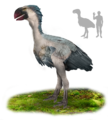Megafauna

In
In practice, the most common usage encountered in academic and popular writing describes land mammals roughly larger than a human that are not (solely) domesticated. The term is especially associated with the
History
One of the earliest occurrences of the term "megafauna" is Alfred Russel Wallace's 1876 work The geographical distribution of animals. He described the animals as "the hugest, and fiercest, and strangest forms". In the later 20th and 21st centuries, the term usually refers to large animals. There are variations in thresholds used to define megafauna as a whole or certain groups of megafauna. Many scientific literature adopt Martin's threshold of (<45 kg) to classify animals under this group. However, for freshwater species, 30 kg is the preferred threshold. Some scientists define herbivorous terrestrial megafauna as having a weight exceeding 100 kg, and terrestrial carnivorous megafauna as more than 15 kg. Additionally, Owen-Smith coined the term megaherbivore to describe herbivores that weighed over a tonne.[1]
Among living animals, the term megafauna is most commonly used for the largest
Ecological strategy
Megafauna animals – in the sense of the largest mammals and birds – are generally
Evolution of large body size
One observation that has been made about the evolution of larger body size is that rapid rates of increase that are often seen over relatively short time intervals are not sustainable over much longer time periods. In an examination of mammal body mass changes over time, the maximum increase possible in a given time interval was found to scale with the interval length raised to the 0.25 power.[7] This is thought to reflect the emergence, during a trend of increasing maximum body size, of a series of anatomical, physiological, environmental, genetic and other constraints that must be overcome by evolutionary innovations before further size increases are possible. A strikingly faster rate of change was found for large decreases in body mass, such as may be associated with the phenomenon of insular dwarfism. When normalized to generation length, the maximum rate of body mass decrease was found to be over 30 times greater than the maximum rate of body mass increase for a ten-fold change.[7]
In terrestrial mammals

Subsequent to the
Megaherbivores eventually attained a body mass of over 10,000 kg. The largest of these,
Terrestrial mammalian carnivores from several
Analysis of the variation of maximum body size over the last 40 Ma suggests that decreasing temperature and increasing continental land area are associated with increasing maximum body size. The former correlation would be consistent with Bergmann's rule,[12] and might be related to the thermoregulatory advantage of large body mass in cool climates,[8] better ability of larger organisms to cope with seasonality in food supply,[12] or other factors;[12] the latter correlation could be explained in terms of range and resource limitations.[8] However, the two parameters are interrelated (due to sea level drops accompanying increased glaciation), making the driver of the trends in maximum size more difficult to identify.[8]
In marine mammals

Since tetrapods (first
Among toothed whales, maximum body size appears to be limited by food availability. Larger size, as in
Cetaceans are not the only marine mammals to reach tremendous sizes.[17] The largest carnivorans of all time are marine pinnipeds, the largest of which is the southern elephant seal, which can reach more than 6 m (20 ft) in length and weigh up to 5,000 kg (11,000 lb). Other large pinnipeds include the northern elephant seal at 4,000 kg (8,800 lb), walrus at 2,000 kg (4,400 lb), and Steller sea lion at 1,135 kg (2,502 lb).[18][19] The sirenians are another group of marine mammals which adapted to fully aquatic life around the same time as the cetaceans did. Sirenians are closely related to elephants. The largest sirenian was the Steller's sea cow, which reached up to 10 m (33 ft) in length and weighed 8,000 to 10,000 kg (18,000 to 22,000 lb), and was hunted to extinction in the 18th century. The semi-aquatic hippopotamus, which is the terrestrial mammal most closely related to cetaceans.[20]
In flightless birds
Because of the small initial size of all mammals following the extinction of the non-avian dinosaurs, nonmammalian vertebrates had a roughly ten-million-year-long window of opportunity (during the Paleocene) for evolution of gigantism without much competition.
Flightless paleognaths, termed
Predatory megafaunal flightless birds were often able to compete with mammals in the early
However, none of the flightless birds of the Cenozoic, including the predatory
In giant turtles
Some earlier aquatic Testudines, e.g. the marine Archelon of the Cretaceous[33] and freshwater Stupendemys of the Miocene, were considerably larger, weighing more than 2,000 kg (4,400 lb).[34]
Megafaunal mass extinctions
Timing and possible causes

The
Outside the mainland of
An analysis of the timing of
An analysis of
Continuing human hunting and environmental disturbance has led to additional
A number of other mass extinctions occurred earlier in Earth's geologic history, in which some or all of the megafauna of the time also died out. Famously, in the Cretaceous–Paleogene extinction event the non-avian dinosaurs and most other giant reptiles were eliminated. However, the earlier mass extinctions were more global and not so selective for megafauna; i.e., many species of other types, including plants, marine invertebrates[78] and plankton, went extinct as well. Thus, the earlier events must have been caused by more generalized types of disturbances to the biosphere.[79]
Consequences of depletion of megafauna
Effect on nutrient transport
Megafauna play a significant role in the lateral transport of mineral nutrients in an ecosystem, tending to translocate them from areas of high to those of lower abundance. They do so by their movement between the time they consume the nutrient and the time they release it through elimination (or, to a much lesser extent, through decomposition after death).
Effect on methane emissions
Large populations of megaherbivores have the potential to contribute greatly to the atmospheric concentration of
Recent studies have indicated that the extinction of megafaunal herbivores may have caused a reduction in
Gallery
Pleistocene extinct megafauna
-
Diprotodon optatum
-
"Varanus priscus),
-
-
American lions (Panthera atrox)
Other extinct Cenozoic megafauna
-
Dromornis stirtoni
-
Asianindricothere and rhino relative Paraceratherium was among the largest land mammals,[90]
-
Reconstructed jaws of megalodon (Otodus megalodon)
-
Kelenken guillermoi
Extant
-
The greater rhea
-
The eastern gorilla
-
The black rhinoceros
-
Unlike woollyQuaternary extinctions.[91]
-
The sperm whale
-
The orca
-
The common ostrich
-
The Komodo dragon
-
Thegreen anaconda
-
The giant sunfish
-
The Nile perch
-
The great white shark, the largest macropredatory fish and one of the largest carnivorous shark species, is found worldwide.[92]
-
The manta
-
Examination of a 9 m giant squid
See also
- Australian megafauna
- Bergmann's rule
- Charismatic megafauna
- Cope's rule
- Deep-sea gigantism
- Island gigantism
- Largest organisms
- Largest prehistoric animals
- List of heaviest land mammals
- List of largest mammals
- List of megafauna discovered in modern times
- Megafauna (mythology)
- Megafaunal wolf
- Megaflora
- Megaherb
- New World Pleistocene extinctions
- Pleistocene megafauna
- Quaternary extinction event
Notes
- ^ Nonavian dinosaur size was not similarly constrained because they had a different relationship between body mass and egg size than birds. The 400 kg Aepyornis had larger eggs than nearly all dinosaurs.[27][28]
- ^ Analysis indicates that 35 genera of North American mammals went extinct more or less simultaneously in this event.[51]
References
- PMID 32126954.
- PMID 26811442.
- PMID 27291051.
- ^ https://www.britannica.com/science/K-selected-species Archived 2016-10-11 at the Wayback Machine. Britannica. Retrieved 2017-4-2.
- S2CID 36156087.
- S2CID 84205755.
- ^ PMID 22308461.
- ^ S2CID 17272200.
- S2CID 206989975. Archived from the original(PDF) on 2019-06-08. Retrieved 2019-07-13.
- ^ .
- PMID 17227145.
- ^ S2CID 205983729.
- ^ Webb J (2015-02-19). "Evolution 'favours bigger sea creatures'". BBC News. BBC. Archived from the original on 2015-02-22. Retrieved 2015-02-22.
- from the original on 2019-07-05. Retrieved 2019-07-13.
- ISSN 0006-3568.
- ^ S2CID 209339266.
- PMID 25848031.
- PMID 25355195.
- ISSN 0824-0469.
- PMID 29618615.
- ^ (PDF) from the original on 2023-03-15. Retrieved 2019-09-24.
- .
- PMID 20525622.
- PMID 24825849.
- ^ ISBN 978-0-253-34282-9. Retrieved 7 January 2012.
- ISBN 978-0-253-34282-9.
- OCLC 42009424. Retrieved 6 May 2013.
- S2CID 85880201.
- ISBN 978-0-253-34282-9.
- doi:10.1111/j.1600-0587.2010.06305.x. Archived from the original(PDF) on July 24, 2011. Retrieved 2011-02-26.
- ISSN 1514-5158.
- ISBN 978-3-030-25865-8, retrieved 2024-03-27
- PMID 21270022.
- PMID 35005268.
- from the original on 2018-06-09, retrieved 2017-09-04
- ^ Corlett RT (2006). "Megafaunal extinctions in tropical Asia" (PDF). Tropinet. 17 (3): 1–3. Archived (PDF) from the original on 2016-03-04. Retrieved 2010-10-04.
- ^ Edmeades B. "Megafauna — First Victims of the Human-Caused Extinction". megafauna.com. (internet-published book with Foreword by Paul S. Martin). Archived from the original on 2014-12-25. Retrieved 2020-02-13.
- ^ from the original on 2024-03-27. Retrieved 2014-11-11.
- ^ PMID 16701402. Archived from the original(PDF) on 2010-06-10. Retrieved 2014-11-11.
- (PDF) from the original on 2019-02-10. Retrieved 2011-08-26.
- S2CID 89272546.
- S2CID 36583693.
- PMID 18719103.
- ^ Roberts R, Jacobs, Z. (October 2008). "The Lost Giants of Tasmania" (PDF). Australasian Science. 29 (9): 14–17. Archived from the original (PDF) on 2011-09-27. Retrieved 2011-08-26.
- ^ from the original on 2012-12-18. Retrieved 2022-02-14.
- from the original on 2022-02-14. Retrieved 2022-02-14.
- PMID 24137797.
- from the original on 2024-03-27. Retrieved 2022-02-14.
- PMID 23650401.
- .
- PMID 19934040.
- ]
- ISBN 978-1-4020-8792-9.
- from the original on 2024-03-27. Retrieved 2016-05-07.
- S2CID 161791746.
- PMID 16085711.
- S2CID 90558542.
- hdl:10289/5404.
- PMID 20713711.
- PMID 15288523.
- PMID 10731144.
- .
- doi:10.1111/j.1748-7692.1995.tb00294.x. Archived from the originalon 2011-05-11. Retrieved 2011-08-30.
- S2CID 31686497.
- .
- ^ Biello D (2012-03-22). "Big Kill, Not Big Chill, Finished Off Giant Kangaroos". Scientific American news. Archived from the original on 2012-03-23. Retrieved 2012-03-25.
- S2CID 36914192.
- ^ S2CID 26675232.
- ^ PMID 26865301.
- PMID 9880249.
- PMID 26823193.
- S2CID 206523763.
- (PDF) from the original on 2017-09-22. Retrieved 2018-11-09.
- ISBN 978-1-4020-8792-9.
- from the original on 2024-03-27. Retrieved 2014-11-11.
- ^ Milman O (February 6, 2019). "The killing of large species is pushing them towards extinction, study finds". The Guardian. Archived from the original on February 7, 2019. Retrieved February 13, 2019.
- .
- PMID 18695240.
- ISSN 1543-592X.
- PMID 23951141.
- ^ Marshall M (2013-08-11). "Ecosystems still feel the pain of ancient extinctions". New Scientist. Archived from the original on 2015-07-04. Retrieved 2013-08-12.
- ^ doi:10.1038/ngeo1895.
- PMID 20949007.
- ^ PMID 22575462.
- ^ "Dinosaur gases 'warmed the Earth'". BBC Nature News. 2012-05-07. Archived from the original on 2015-12-01. Retrieved 2012-05-08.
- ^ doi:10.1038/ngeo877.
- .
- ISBN 978-1-84028-152-1.
- S2CID 92143497.
- S2CID 54686160.
- S2CID 41295526.
- ^ Sample, Ian (19 February 2010). "Great white shark is more endangered than tiger, claims scientist". The Guardian. Archived from the original on 9 September 2013. Retrieved 14 August 2013.





![Macrauchenia was the last and largest litoptern, an order of extinct South American native ungulates.[88][89]](http://upload.wikimedia.org/wikipedia/commons/thumb/6/64/Macrauchenia_%28reconstruction%29.jpg/120px-Macrauchenia_%28reconstruction%29.jpg)















![Unlike woolly rhinos and mammoths, muskoxen narrowly survived the Quaternary extinctions.[91]](http://upload.wikimedia.org/wikipedia/commons/thumb/e/ed/Ovibos_moschatus_qtl3.jpg/120px-Ovibos_moschatus_qtl3.jpg)













